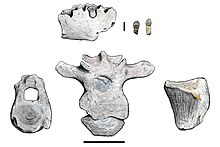Antarctopelta
| Antarctopelta | ||||||||||||
|---|---|---|---|---|---|---|---|---|---|---|---|---|
| Temporal occurrence | ||||||||||||
| Upper Cretaceous (late Campanium ) | ||||||||||||
| 76.4 to 72 million years | ||||||||||||
| Locations | ||||||||||||
| Systematics | ||||||||||||
|
||||||||||||
| Scientific name | ||||||||||||
| Antarctopelta | ||||||||||||
| Salgado & Gasparini , 2006 | ||||||||||||
| species | ||||||||||||
|
Antarctopelta is a little-known genus of the bird pelvic dinosaur (Ornithischia) from the group of the Ankylosauria . She lived in the Upper Cretaceous in what is now Antarctica .
features
With an estimated four meters in length, Antarctopelta was a rather small ankylosaur. Like the rest of this group, he was a stocky animal with short, strong limbs. Its torso was covered with armor made of bone plates (osteoderms). A total of six different types of plates were found, but mostly not connected to the skeleton, so that their exact arrangement remains unclear. Flat, elongated plates probably covered the neck; large, round plates, presumably covered with small bumps, may have been placed in the pelvic region. Oval, keeled osteoderms were also found; these probably ran along the animal's flanks and thus offered additional protection. As with some other ankylosaurs, bony spines may also have been present. In the area of the tail, the remains of ossified tendons were found, which stiffened the tail and may indicate a bony tail lobe. However, this has not yet been discovered.
The skull is poorly preserved, but the findings indicate that it was also armored. There was a bony horn behind each eye. The teeth of Antarctopelta were leaf-shaped like all ankylosaurs, but larger than those of other species. He lived on plants.
The climate of the Antarctic was warmer in the Cretaceous than today, the continent was ice-free and the habitat of this dinosaur was probably coniferous or deciduous forests.
Discovery and naming
The first fossil remains of the holotype of antarctopelta were 1,986 on the James Ross Island off the coast of the Antarctic Peninsula discovered. The fossil was recovered due to the weather and the frozen ground, spread over several excavations between 1991 and 2001. Parts of the skeleton - especially close to the surface of the earth - were also poorly preserved due to frost weathering . Antarctopelta is the first dinosaur found in Antarctica ( Cryolophosaurus , however, was first described earlier and is therefore considered the first dinosaur to be found and described in Antarctica). The remains of Antarctopelta come from shallow marine sediments of the Santa Marta Formation , in which they were embedded along with fossils of ammonites , mussels and sea slugs, as well as a single shark tooth . However, like all ankylosauria, the Antarctopelta lived on land, so the exposed specimen probably only ended up in the sea after its death.
Parts of the finds had already been briefly described in the specialist literature in 1987 and 1991, but the dinosaur was only given its name in 2006, around five years after the last excavation, by the Argentine paleontologists Leonardo Salgado and Zulma Gasparini. The name Antarctopelta is derived from the place where it was found and the Greek πελτα / pelta (= "shield") - a common part of the name of ankylosaurs. The only known way and type species is antarctopelta oliveroi whose epithet the original discoverer, Eduardo Olivero, honors. The finds are dated to the late Cretaceous (upper Campanium ) by means of the ammonites found in the same layer , which corresponds to an age of approx. 76 to 72 million years.
Systematics
The exact systematic position of Antarctopelta within the Ankylosauria is unclear. The first descriptors could not assign him to either of the two families and classified him as "Ankylosauria incertae sedis ". Although it was subsequently placed among the nodosaurids , this assignment is not considered to be certain.
literature
- Leonardo Salgado, Zulma Gasparini: Reappraisal of an ankylosaurian dinosaur from the Upper Cretaceous of James Ross Island (Antarctica). In: Geodiversitas. Vol. 28, No. 1, 2006, ISSN 1280-9659 , pp. 119-135 ( PDF ; 3.95 MB).
- Matthew K. Vickaryous, Teresa Maryańska, David B. Weishampel: Ankylosauria. In: David B. Weishampel, Peter Dodson, Halszka Osmólska (eds.): The Dinosauria . 2nd edition. University of California Press, Berkeley CA et al. 2004, ISBN 0-520-24209-2 , pp. 363-392.
Individual evidence
- ↑ Alejandro Otero, Marcelo Reguero: Dinosaurs (Reptilia, Archosauria) at Museo de La Plata, Argentina: annotated catalog of the type material and Antarctic specimens. Palaeontologia Electronica. Vol. 16, No. 1, 2013, 3T ( online ), p. 16 f.
